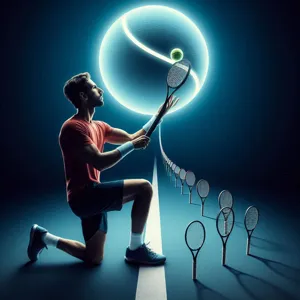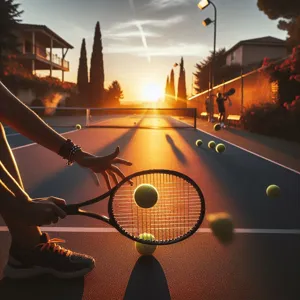Tennis is a sport of precision, agility, and strategy, where every stroke can determine the outcome of a match.
While natural talent and flair can certainly give you an edge, it is consistency that truly sets great players apart from the rest. Mastering consistency not only enhances your performance but also builds confidence on the court, allowing you to execute your shots with finesse and control. Whether you’re a beginner eager to improve or an experienced player looking to refine your technique, understanding the fundamentals of consistency is crucial to elevating your game. In this blog post, we will explore top tips and strategies that will help you develop a steadier playing style, enhance your shot accuracy, and ultimately transform your tennis experience into one of sustained success and enjoyment. Get ready to take your game to the next level with practical insights that will have you hitting those perfect shots time and time again!
1. Understanding the Importance of Consistency in Tennis

When it comes to tennis, the difference between a good player and a great one often boils down to one crucial factor: consistency. Understanding the importance of consistency in tennis is the first step towards elevating your game. Consistency is not just about hitting the ball well; it’s about delivering reliable performances match after match, point after point.
Imagine being in the heat of a tightly contested match. Your opponent is skilled, and the pressure mounts with each passing game. In these high-stakes moments, it’s the player who can maintain composure and accuracy, even under duress, who will come out on top. This ability to consistently place the ball where you want it—whether it’s a deep forehand down the line or a delicate drop shot—can make a world of difference.
Moreover, consistency breeds confidence. When you trust that you can execute your shots reliably, it allows you to focus on strategy rather than worrying about whether you’ll miss your next serve. This mental clarity is vital for peak performance, enabling you to anticipate your opponent’s moves and respond effectively.
Beyond individual shots, consistency in your routines—such as warm-ups, practice drills, and match preparation—can significantly impact your performance. Establishing a reliable pre-match routine helps to settle nerves and set a positive tone for the game ahead.
In summary, consistency is the backbone of a successful tennis game. It encompasses not just the technical execution of shots, but also the mental and strategic aspects of the sport. By prioritizing consistency in practice and matches, you lay the foundation for a more resilient and formidable tennis game.
2. Assessing Your Current Skill Level
Before embarking on a journey to elevate your tennis game, it’s crucial to take a step back and assess your current skill level. This self-evaluation serves as the foundation for your development, allowing you to identify strengths to build upon and weaknesses that require attention.
Begin by reflecting on the fundamental aspects of your game: your serving technique, forehand and backhand strokes, footwork, and overall court awareness. You may consider recording yourself during practice sessions to gain a clear perspective of your mechanics. Watching these recordings can highlight areas for improvement that you might not notice in the moment.
Additionally, seeking feedback from a coach or experienced players can provide invaluable insights. They can offer a fresh perspective on your form and strategies, suggesting targeted drills and exercises designed to enhance your performance. Don’t shy away from honest critiques; they are essential for growth.
Moreover, assess your match play experiences. How do you handle pressure situations? Are you consistent in your performance, or do nerves get the best of you? Understanding your mental game is just as important as your physical abilities. Consider keeping a journal of your matches, noting what worked well and where you faltered.
By thoroughly assessing your current skill level, you lay a solid groundwork for your training plan. This clarity will not only help you set realistic goals but also enable you to track your progress over time, ensuring that every practice session contributes to your journey of mastering consistency on the court.
3. Setting Realistic Goals for Improvement

Setting realistic goals for improvement is a cornerstone of elevating your tennis game. As you step onto the court, it’s essential to understand that progress in tennis, much like in any sport, is a journey rather than a destination. Establishing achievable goals will not only fuel your motivation but also provide you with a clear roadmap to enhance your skills.
Begin by assessing your current level of play. Are you struggling with your serve? Is your footwork lacking? Identifying specific areas that need improvement allows you to set targeted goals. Instead of vague aspirations like “I want to get better at tennis,” aim for more concrete objectives, such as “I want to improve my serve accuracy by 20% within the next month” or “I want to increase my rally consistency during practice sessions.”
Break these larger goals down into smaller, manageable milestones. For instance, if your ultimate goal is to enhance your baseline game, you might set weekly targets, such as practicing your forehand and backhand strokes for 30 minutes each day. Celebrate these small victories; each step forward builds your confidence and reinforces your commitment to improvement.
Additionally, it’s crucial to remain flexible and adjust your goals as you progress. If you find that a certain target is too easy, challenge yourself further. Conversely, if you’re struggling to meet a goal, reassess and modify it to ensure it remains attainable. Remember, the key is to keep pushing yourself while also allowing room for growth and adaptation.
Lastly, consider sharing your goals with a coach or a training partner. Not only will this add a layer of accountability, but it can also lead to valuable feedback that will further refine your approach. By setting realistic and strategic goals, you create a structured path to success that keeps you engaged, motivated, and, ultimately, on the path to mastering your tennis game.
4. Developing a Structured Practice Routine
Developing a structured practice routine is the cornerstone of elevating your tennis game. Just like a finely tuned machine, your skills need regular maintenance and adjustment to run smoothly on the court. A well-organized practice schedule not only enhances your technical abilities but also builds the mental fortitude required for competitive play.
Start by assessing your current skill level and identifying areas that need improvement. Are your serves lacking power? Is your footwork sluggish? Once you pinpoint these aspects, you can create a focused practice plan. Divide your sessions into specific segments that target different elements of the game—serves, volleys, groundstrokes, and match play. For instance, dedicate the first 20 minutes to working on your serve technique, followed by 30 minutes of rallying with a partner to enhance your groundstrokes, and conclude with 10 minutes of agility drills to sharpen your footwork.
Incorporate variety into your routine to keep it engaging. Alternate between solo drills, partner exercises, and match simulations. This not only helps stave off monotony but also allows you to experience different game scenarios. Moreover, set measurable goals for each practice session. Whether it’s achieving a certain number of successful serves or improving your rally consistency, having clear objectives will keep you motivated and accountable.
Consistency is key, so strive to practice at the same time each week, creating a habitual rhythm that your body and mind can adapt to. Remember, quality trumps quantity; it’s better to have focused, high-intensity practice sessions than extended periods of wandering aimlessly. Lastly, don’t forget to incorporate rest days into your routine. Recovery is just as important as practice in building strength and preventing injuries.
By developing and adhering to a structured practice routine, you’ll not only see significant improvements in your game but also foster a deeper connection with the sport you love. The more organized and intentional your practice becomes, the more confident and capable you’ll feel on the court, setting the stage for your best performance yet.
5. Focusing on Footwork and Positioning

When it comes to mastering consistency in tennis, focusing on footwork and positioning is paramount. Your footwork is the foundation upon which your entire game is built; it’s what allows you to reach the ball in time, set up for your shots, and maintain balance during play. Good footwork not only helps you to move quickly across the court but also ensures that you can execute your strokes with precision and power.
Start by developing a habit of staying light on your feet. This means maintaining a slight bend in your knees and being ready to spring into action at a moment’s notice. Practice drills that emphasize agility, such as ladder drills or cone sprints, to improve your speed and coordination. The quicker your feet move, the better positioned you’ll be to hit the ball effectively.
Next, work on understanding court positioning. Whether you’re at the baseline or moving toward the net, knowing where to stand can make all the difference. For instance, while at the baseline, aim to position yourself a few feet behind the line to give yourself ample time to react to your opponent’s shots. Conversely, when approaching the net, move in quickly and decisively, positioning yourself to intercept volleys and put pressure on your opponent.
Incorporate shadow swings into your practice routine to build muscle memory and improve your movement efficiency. Focus on visualizing the ball’s trajectory and where your feet should be as you prepare to strike it. This will help you develop a more instinctive response during matches, allowing you to anticipate your opponent’s shots and react accordingly.
Ultimately, enhancing your footwork and positioning will not only improve your consistency but also elevate your overall game. By mastering these fundamentals, you’ll find yourself more agile and better equipped to handle the ebb and flow of a match, leading to improved performance and greater enjoyment on the court. Remember, in tennis, it’s not just about hitting the ball; it’s about being in the right place at the right time.
6. The Role of Mental Toughness in Consistency
When it comes to mastering consistency in tennis, mental toughness is the unsung hero that can significantly influence your performance on the court. While physical skills such as serving, volleying, and footwork are undeniably crucial, the ability to maintain a strong, focused mindset often separates the good players from the great ones. Mental toughness is about how well you can handle pressure, manage your emotions, and stay committed to your game plan, even when the stakes are high.
Picture this: you’re in the middle of a tense match, the score is tight, and your opponent is relentless. It’s easy to succumb to frustration or doubt during these high-pressure moments. However, mentally tough players thrive in such situations. They possess the ability to block out distractions, remain calm under pressure, and stay focused on their strategy. This resilience helps them maintain consistent performance, even when faced with challenges.
To cultivate mental toughness, start by embedding mindfulness practices into your training routine. Techniques such as visualization can help you prepare for various match scenarios, allowing you to mentally rehearse your responses to pressure situations. Additionally, implementing positive self-talk can reinforce your confidence, reminding you of your strengths and past successes when things get tough.
Another key aspect of mental toughness is learning how to embrace failure. Instead of viewing mistakes as setbacks, see them as opportunities for growth. Analyze what went wrong and adjust your approach for the next point or match. This mindset shift not only promotes consistency but also fosters resilience, enabling you to bounce back stronger after each challenge.
Incorporating these mental strategies into your training will not only enhance your on-court consistency but also elevate your overall game. As you develop mental toughness, you’ll find yourself navigating the ups and downs of tennis with greater ease, allowing your physical skills to shine through when it matters most. After all, tennis is as much a mental game as it is physical, and mastering this aspect can be the key to unlocking your full potential on the court.
7. Techniques for Improving Your Serve

A powerful serve can set the tone for the entire match, making it one of the most crucial aspects of your tennis game. Mastering your serve requires a combination of technique, practice, and mental focus. Here are some effective techniques to help elevate your serve and make it a formidable weapon on the court.
**1. Perfect Your Grip:** The grip you choose can significantly impact your serve’s accuracy and spin. The Continental grip is a popular choice among many players as it allows for versatility in shot-making. Experiment with different grips to find what feels most comfortable and effective for your style.
**2. Focus on Your Stance:** Your stance plays a vital role in generating power and stability. Position your feet shoulder-width apart and slightly staggered, with your non-dominant foot forward. This setup not only enhances balance but also facilitates the transfer of weight through your serve.
**3. Use a Full Backswing:** A complete backswing is essential for generating the necessary racket head speed. As you toss the ball, bring your racket back fully, allowing your body to coil. This motion creates potential energy that you can unleash as you swing forward to strike the ball.
**4. Master the Toss:** The toss is the foundation of a successful serve. Aim to toss the ball high and slightly in front of you, ensuring it reaches its peak just as you’re about to make contact. Consistency in your toss height and location is key, and practicing this element can drastically improve your serve’s reliability.
**5. Engage Your Core:** A strong core is crucial for an effective serve. Engage your abdominal muscles as you prepare to hit, which will help you maintain balance and generate more power. A stable core allows for a seamless transfer of energy from your legs through your torso to your arm.
**6. Follow Through:** The follow-through is often overlooked, but it’s essential for ensuring accuracy and reducing the risk of injury. After making contact with the ball, allow your racket to continue its motion naturally, finishing high above your shoulder. This not only helps with follow-through accuracy but also allows for better spin.
**7. Practice, Practice, Practice:** Like any skill in tennis, improving your serve requires dedicated practice. Set aside specific practice sessions to focus solely on your serve. Use drills that emphasize different elements of the serve, such as accuracy, spin, and speed. Consider recording your serves to analyze your technique and make necessary adjustments.
By implementing these techniques into your training regimen, you’ll not only enhance your serve but also instill confidence in your overall game. Remember, a strong serve can give you the edge you need to dominate on the court, keeping your opponents on the defensive and setting you up for success in every match.
8. Mastering Groundstrokes: Key Drills and Tips
Mastering groundstrokes is essential for any tennis player looking to elevate their game. Groundstrokes, which include both forehands and backhands, form the backbone of your play, allowing you to dictate rallies and establish control on the court. To hone these vital skills, it’s important to incorporate a range of targeted drills and techniques into your training routine.
One fundamental drill to consider is the **two-ball drill**, where you hit two balls in quick succession, focusing on maintaining proper footwork and rhythm. Start by rallying with a partner, aiming to keep the ball in play for as long as possible. As you grow more comfortable, increase the pace to challenge your timing and reflexes. This drill not only sharpens your consistency but also helps you develop the ability to handle different ball trajectories.
Another effective exercise is the **cross-court rally drill**. Position yourself on one side of the court and have a partner stand diagonally opposite. Focus on hitting the ball cross-court, emphasizing the use of topspin to lift the ball over the net while still maintaining depth. This drill encourages you to utilize the full width of the court, which is crucial for developing angles and creating opportunities during a match.
In addition to these drills, pay attention to your **stance and grip**. A stable, balanced stance allows for better weight transfer and shot execution. Experiment with different grips—such as the eastern grip for your forehand and the continental grip for your backhand—to find what feels most comfortable and effective for you. Remember, consistency is built on proper technique, so take the time to focus on your form during practice sessions.
Lastly, don’t forget the importance of **mental focus** when working on your groundstrokes. Visualize your shots and set specific goals for each practice session. Whether it’s hitting a certain number of cross-court shots in a row or working on your backhand down the line, having clear objectives will help you stay focused and motivated.
By incorporating these drills, tips, and mental strategies into your training regimen, you’ll be well on your way to mastering your groundstrokes and taking your tennis game to the next level. Consistent practice will not only improve your technique but also boost your confidence, enabling you to approach matches with greater assurance and skill.
9. Enhancing Your Volleying Skills
Volleying is a crucial aspect of tennis that can often be the deciding factor in a match. It requires a unique blend of timing, footwork, and hand-eye coordination to execute effectively. To enhance your volleying skills, start by focusing on your stance and positioning. A solid foundation is essential; your feet should be shoulder-width apart, knees slightly bent, and weight balanced on the balls of your feet. This readiness allows you to adjust quickly to the ball’s trajectory and speed.
Next, practice your grip. The continental grip is most commonly recommended for volleys, as it provides the versatility needed to handle balls coming from various angles. Spend time hitting against a wall or with a partner, concentrating on your follow-through, which should be short and compact. Remember, the volley is not about power; it’s about placement and control. Aim for the corners of the court or try to catch your opponent off-guard with a soft touch.
Incorporate drills that simulate match conditions to develop your reflexes and reaction time. One effective drill is the “volley-to-volley” exercise, where you and a partner stand close to the net and exchange volleys back and forth. Focus on maintaining a consistent rhythm and improving your accuracy. Also, don’t forget to practice your overhead volleys; they can be game-changers when executed well.
Finally, mental preparation cannot be overstated. Visualize yourself successfully executing volleys in high-pressure situations. This mental rehearsal will boost your confidence and reinforce muscle memory. By dedicating time and effort to enhancing your volleying skills, you’ll find that not only will your confidence grow, but so will your overall performance on the court. Embrace the challenge and watch as your game elevates to new heights.
10. The Power of Visualization and Positive Self-Talk
In the world of tennis, where every swing and serve counts, mental fortitude is just as crucial as physical skill. One of the most powerful tools in enhancing your game is the practice of visualization and positive self-talk. Imagine stepping onto the court, feeling the sun warm your face, the rhythmic sound of your heartbeat syncing with the thud of your tennis shoes against the surface. Now, picture yourself executing flawless serves, powerful groundstrokes, and strategic volleys. This mental imagery is not just daydreaming; it’s a proven technique that elite athletes use to prepare their minds for competition.
Visualization involves creating a detailed mental picture of yourself performing at your best. Before a match, take a few moments to close your eyes and visualize each aspect of your game: the feel of the racket in your hand, the trajectory of the ball as you strike it, and the satisfaction of watching it land precisely where you intended. This practice conditions your brain to recognize success, boosting your confidence and sharpening your focus when it really matters.
But visualization alone isn’t enough. Pair it with positive self-talk to create a powerful mental framework. Replace negative thoughts—those nagging doubts about missing a shot or losing a game—with affirmations that reinforce your abilities and resilience. Phrases like “I am a strong competitor” or “Every point is a new opportunity” can transform your mindset, pushing you to embrace challenges rather than shy away from them.
Incorporating these techniques into your training routine can significantly enhance your performance on the court. Spend a few minutes each day practicing visualization and crafting your positive affirmations. Over time, you will notice a shift in your mental approach to the game, leading to increased consistency, improved focus, and ultimately, better results in your matches. Embrace the power of your mind, and watch as it elevates your tennis game to new heights.
11. Incorporating Match Play and Simulation
Incorporating match play and simulation into your training routine is crucial for translating the skills you’ve honed in practice into real-game scenarios. While drilling strokes and footwork is essential, nothing quite replicates the intensity and unpredictability of a live match. Engaging in match play allows you to experience the pressure of competition, where every point matters and strategic thinking comes into play.
To begin, seek out practice partners who can challenge you at your level or slightly above, pushing you to adapt and refine your skills on the fly. Organizing friendly matches not only builds your competitive spirit but also helps you develop your mental resilience. Pay attention to how you respond to pressure situations—are you able to execute your game plan, or do you falter under stress? This self-awareness is invaluable for growth.
Additionally, consider incorporating match simulations into your training. This could mean setting up specific scenarios during practice, such as playing out a tiebreaker or simulating being down a break in the final set. This focused approach encourages you to cultivate a strategic mindset, preparing you to manage various game situations effectively.
Video analysis can also play a significant role in this process. Recording your match play allows you to review your performance, identifying strengths and areas for improvement. Watching how you handle different points, your shot selection under pressure, and your court positioning can provide critical insights that drills alone might not reveal.
Ultimately, blending match play with your training regimen not only sharpens your technical abilities but also enhances your tactical understanding of the game. By regularly putting yourself in competitive environments, you’ll build the confidence and mental fortitude necessary to elevate your performance on the court and handle whatever challenges come your way.
12. Tracking Progress and Adjusting Your Training
Tracking your progress and adjusting your training regimen are vital components of mastering consistency in your tennis game. Just as a skilled artist regularly evaluates their brushstrokes, or a musician listens to their playbacks, you too must take the time to assess your performance on the court. This involves keeping a detailed record of your practice sessions, match results, and even your physical condition on game days.
Consider maintaining a training journal where you can jot down specific statistics such as your first serve percentage, unforced errors, and successful rallies. Note how you felt during each session—were you agile on your feet? Did you find your backhand powerful or lacking? This self-reflection not only helps you identify patterns in your performance but also highlights areas that need improvement.
Moreover, technology can be your ally in this endeavor. Various apps and wearable devices are available that track metrics like shot speed, spin rate, and match statistics. These tools provide invaluable insights that can guide your training decisions. For example, if your data shows that your forehand consistently outperforms your backhand, you might decide to dedicate more time to honing your weaker strokes, ensuring a more balanced game.
Regularly reviewing your progress is essential, but so is the willingness to adapt your training based on your findings. If you notice a plateau in your performance or if certain drills are no longer yielding results, don’t hesitate to switch things up. Consult with a coach for a fresh perspective, integrate new drills, or even explore different playing styles. By being proactive and flexible in your approach, you’ll not only keep your training sessions engaging but also foster a deeper understanding of your game.
In summary, tracking your progress and being open to adjustments are key to elevating your tennis skills. Embrace this process as a journey rather than a destination, and you’ll find that the path to consistency is paved with continuous improvement and newfound excitement for the game.
13. Learning from Consistent Players: Analyzing Their Techniques
One of the most effective ways to elevate your tennis game is to learn from those who consistently perform at a high level. Whether you admire professional players on the ATP or WTA tours or local club champions, analyzing their techniques can provide invaluable insights that you can incorporate into your own practice.
Start by observing their footwork—notice how they glide effortlessly across the court, positioning themselves perfectly for each shot. Consistent players often exhibit exceptional balance and agility, enabling them to respond quickly to their opponent’s moves. Pay attention to their shot selection as well; they know when to play aggressively and when to adopt a more defensive strategy. This awareness is rooted in their understanding of the game and their ability to read their opponents.
Next, focus on their strokes. How do they generate power while maintaining control? What grips do they use for different shots? Take the time to break down their serve, forehand, and backhand. Many consistent players have a unique rhythm and timing that enhances their performance. You can improve your own game by trying to replicate these elements in practice sessions and drills.
Additionally, don’t underestimate the mental aspect of their game. Consistent players often exhibit a strong sense of focus and composure, even during high-pressure situations. Consider analyzing their match footage to understand how they handle adversity, maintain concentration, and adapt their strategies as the match unfolds.
Remember, mastering consistency in tennis isn’t just about mimicking the techniques of others; it’s about understanding the principles behind their success. By studying these players and incorporating their strategies into your training, you can develop a more well-rounded game and find your own path to consistency on the court.
14. Staying Motivated Through Challenges
Tennis is a sport that demands not just physical prowess but also mental resilience. As you journey through the peaks and valleys of your training and competition, staying motivated during challenging times can often feel daunting. However, it is precisely during these moments of adversity that your commitment to improvement can truly shine.
To maintain motivation, start by setting specific, achievable goals that reflect both your long-term aspirations and your short-term progress. Whether it’s mastering a new serve, improving your footwork, or simply aiming for consistency in practice, having clear objectives can help you stay focused. Celebrate small victories along the way, as these milestones will fuel your enthusiasm and reinforce your commitment to the game.
Additionally, surround yourself with a supportive network. Engaging with fellow players, coaches, or even friends who share your passion for tennis can provide the encouragement you need during tough times. Share your struggles and victories, and lean on each other for advice and motivation. Sometimes, just knowing that others are facing similar challenges can lift your spirits and reignite your passion for the sport.
Visualize your success as well. Take a few moments before practice or matches to picture yourself executing your shots flawlessly, winning crucial points, or even overcoming obstacles during a tough match. This mental imagery can not only bolster your confidence but also remind you of why you love playing tennis in the first place.
Lastly, remember to embrace the journey. Every athlete faces challenges, and each setback can be a lesson in disguise. Rather than viewing obstacles as reasons to falter, see them as opportunities to grow stronger and more resilient. By fostering a positive mindset and staying committed to your goals, you’ll find that motivation can flourish even in the most challenging of times, ultimately elevating your tennis game to new heights.
15. Conclusion: The Journey to Consistency in Tennis
In the world of tennis, consistency is the bedrock upon which champions are built. As we’ve explored throughout this post, the journey to achieving a steady and reliable game is not just about perfecting technique or acquiring the latest gear; it’s about cultivating a mindset that embraces growth and persistence.
Consistency in tennis is a multifaceted endeavor. It requires disciplined practice, a deep understanding of your own strengths and weaknesses, and the ability to adapt under pressure. By incorporating drills that focus on repetition, engaging in mental conditioning techniques, and setting achievable goals, you can transform your game one step at a time.
Remember, the road to consistency is rarely a straight line. It will undoubtedly be filled with highs and lows, triumphs and setbacks. Embrace each moment as a learning opportunity and recognize that every great player has faced their share of challenges. It’s in these moments of adversity that you will discover the true essence of your resilience and dedication to the sport.
As you head out onto the court, keep in mind that mastery is a continual process. Celebrate your small victories, stay committed to your training, and maintain a positive attitude. With each practice session, you are not just honing your skills; you are building the foundation of a consistent player who can withstand the test of time. So lace up your shoes, grab your racket, and embark on this journey with the confidence that you are becoming the best player you can be. The pursuit of consistency is not just a goal—it’s a lifelong passion that will elevate your game to new heights.
As we conclude our exploration of mastering consistency in your tennis game, remember that the journey to improvement is just as important as the destination. By implementing the top tips we’ve shared—from perfecting your footwork and honing your serve to developing a focused mindset—you’ll not only enhance your performance on the court but also cultivate a deeper love for the game. Consistency takes time, patience, and practice, so be kind to yourself as you work through these strategies. Embrace the process, celebrate your progress, and before you know it, you’ll be playing with a newfound confidence and skill. Now, grab your racket, hit the courts, and put these tips into action—your best game is just around the corner!






